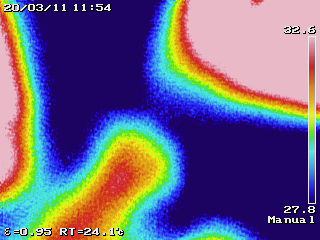Creating an Object Tracker
Written on February 10th, 2020 by EricIn order to effectively target weeds while on a moving platform, we need a way to track them and identify them between consecutive frames.
Matching the Weeds
In order to match weeds between consecutive frames the following simple logic is used:
- Create a matrix which the distances between each new and old object:
__ new_objects ---> __ active_objects | D_1,1 . . . . . . D_1,n| | | . . | | | . . | | | D_m,1 D_m,n| V |__ __| - Sort within each row so that min distance is in first column
- Sort the rows based on the distance in the first column
- Match each new object with the active object that is the lowest distance (euclidean), within a tolerance
In order to do this effectively, we create a matrix of distances:
/* 1. calculate distance between each current point and each new point */
int32_t m = m_active_objects.size();
int32_t n = new_objs.size();
std::vector< std::vector<distance> > dist_matrix(m, std::vector<distance>(n));
for (int i = 0; i < m; i++)
{
for (int j = 0; j < n; j++)
{
object crnt_obj = m_active_objects[m_id_list[i]];
dist_matrix[i][j] = euclidean_distance(crnt_obj, new_objs[j]);
}
}
Then we create a matrix of indices to our objects:
/* 2. Sort by distance */
// Keep track of indices -- new objs
// | 0 1 - - - - - n |
// | 0 1 - - - - - n |
// | - - - - - - - - |
// | - - - - - - - - |
// | 0 1 - - - - - n |
std::vector<std::vector<size_t> > sorted_ids(m, std::vector<size_t>(n));
for (int i = 0; i < m; i++)
std::iota(sorted_ids[i].begin(), sorted_ids[i].end(), 0);
// Keep track of indices -- active objs
// | 0 1 - - - - - m |
std::vector<size_t> active_obj_ids(m);
std::iota(active_obj_ids.begin(), active_obj_ids.end(), 0);
Then we sort intra-row as previously mentioned (we use a custom lambda comparator in order to sort the id matrix based on the distance matrix):
// Sort intra-row (find closest new object to each old object)
// | 0 1 - <---> - n |
// | 0 1 - <---> - n |
// | - - - <---> - - |
// | - - - <---> - - |
// | 0 1 - <---> - n |
for (int i = 0; i < m; i++)
{
std::sort(sorted_ids[i].begin(), sorted_ids[i].end(),
[&dist_matrix, &i](const size_t& a, const size_t& b) -> bool
{
return dist_matrix[i][a] < dist_matrix[i][b];
});
}
Then we sort the rows using a similar method:
// Sort the rows based on min distance in each row
// | 0 1 - <---> - m |
std::sort(active_obj_ids.begin(), active_obj_ids.end(),
[&dist_matrix, &sorted_ids](const size_t& a, const size_t& b) -> bool
{
return dist_matrix[a][sorted_ids[a][0]] < dist_matrix[b][sorted_ids[b][0]];
});
Then for each active object we iterate over our sorted_ids and take the first one that matches and update our current active object.
// Loop over each active object
for (auto itr = active_obj_ids.begin(); itr != active_obj_ids.end(); itr++)
{
// loop over each new object in the row
for (auto sub_itr = sorted_ids[*itr].begin(); sub_itr != sorted_ids[*itr].end(); sub_itr++)
{
// Update here ...
}
}
The Details
In order to avoid false positives, we only register new objects once they’ve been seen for a specified number of consecutive frames. Further, when we lose sight of an object we continue tracking it for a specified number of frames and discard it after that.
Targeting
In order to make sure we get as many weeds as possible, we keep our weeds in a queue sorted by ‘y’ coordinate. In other words, the next weed to be going out of frame is the first one we target.

